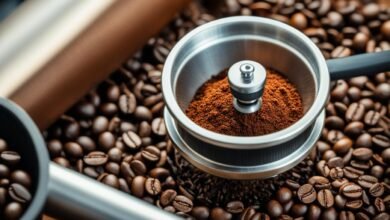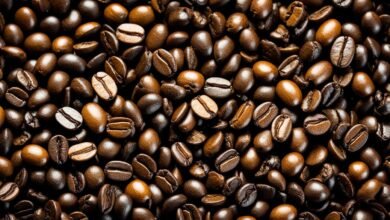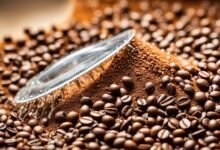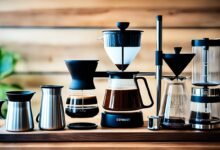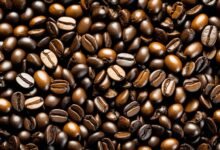The Importance of Coffee Grind Size

I’ve spent many mornings adjusting my coffee beans’ grind size, searching for the perfect cup. The grind size is key to a great cup of coffee. It affects the flavor and how well the coffee extracts.
If you’re into coffee or just starting, knowing about grind size is vital. We’ll look into the science of grind size and its effects. We’ll also talk about choosing the right grind for your coffee maker. Let’s improve our coffee game and make a brew that wows everyone.
Key Takeaways
- The size of coffee grounds significantly impacts the flavor, extraction rate, and overall quality of the brew.
- Finer grinds have a larger surface area, leading to faster extraction and more intense flavors, while coarser grinds result in a slower, milder extraction.
- Choosing the appropriate grind size is crucial for optimizing the brewing process and preventing over-extraction or under-extraction.
- Different brewing methods, such as espresso, drip, and French press, require specific grind sizes to achieve the desired results.
- Investing in a quality burr grinder can help ensure consistent, uniform grind size for a more balanced and flavorful cup of coffee.
What is Grind Size and Why Does it Matter?
The grind size of your coffee beans is key to the taste and quality of your coffee. It’s about how fine or coarse the ground coffee is. This matters a lot because it affects how the water moves through the coffee during brewing.
Impact on Flavor and Extraction
A coarse grind lets water flow easily through the coffee grounds. This means the water extracts the flavors slowly. On the other hand, a fine grind makes water move slower and extract faster. Finding the right grind size is vital for the best taste and avoiding too much or too little extraction.
Coarse vs. Fine Grinds
- Coarse grind: Perfect for methods like French press, where the water has time to bring out the best flavors.
- Fine grind: Best for quick methods like espresso, where the water quickly extracts the coffee’s flavors.
Getting the grind size right is key to enjoying your coffee fully. The right grind can make your coffee taste amazing, avoiding bitterness or weakness.
How Grind Size Affects Extraction Rate
The size of your coffee grounds is key to how fast the coffee extracts. Finer grinds mean more surface area. This lets the water touch more of the coffee, making extraction faster. More of the coffee’s flavors get into the water this way.
Surface Area and Contact Time
On the other hand, coarser grinds mean less surface area. This leads to slower extraction and might make the coffee taste too weak or too bitter. If the grind size is off, you might get a coffee that’s too strong or too weak.
Finding the right grind size is crucial for great coffee. Try adjusting the grind to see what works best for you. This can help you get the taste you like.
| Grind Size | Extraction Rate | Brew Time | Taste Profile |
|---|---|---|---|
| Coarse | Slower | Longer | Weaker, underextracted |
| Fine | Faster | Shorter | Stronger, overextracted |
Keeping the grind size consistent is important. This helps avoid issues with under or over-extraction. Different grinds extract at different rates, changing the flavor. Tools like the Kruve Sifter help you get the right grind size.

Understanding how grind size affects surface area and contact time helps you brew better coffee. Make adjustments to get a delicious cup every time.
Importance, Coffee, Grind Size
The size of your coffee grounds is key to a perfect brew. It affects how well the coffee’s flavors come out, changing the taste and quality of your coffee. By knowing how grind size affects extraction, we can make sure our coffee is always tasty and balanced.
Grind size is vital for the Importance, Coffee, and Flavor of your coffee. For example, espresso needs a fine grind for quick extraction under high pressure. But, a French press uses a coarse grind to prevent over-extraction as it steeps in water for a while.
Pour-over brewers usually go for a medium grind, except for Chemex, which likes a bit coarser. Turkish coffee needs an even finer grind than espresso. A Moka pot prefers a medium-fine grind. Knowing these Grind Size needs for each brewing method is key for the right Consistency and Brewing quality.
“The size of your coffee grounds is crucial for achieving the perfect brew. Grind size directly impacts the extraction of the coffee’s flavor compounds, which in turn affects the overall taste and quality of your cup.”
Burr grinders are better than blade grinders for Consistency because they crush beans evenly. The Baratza Encore, with 40 grind settings, works for many brewing methods. Hand grinders like the Hario Skerton are great for travel and give consistent grinds.

The Importance of coffee Grind Size is huge for trying new recipes and improving flavor extraction and brew quality. By understanding grind size and its effects on brewing, we can make the most of our coffee and always have a great cup.
Choosing the Right Grind for Your Brewing Method
Finding the perfect cup of coffee is more than just picking the right beans and roast. The grind size is also key. Each brewing method needs a specific grind size for the best taste and extraction. Knowing what grind size to use can bring out the best in your coffee.
Grind Sizes for Common Brewing Methods
- French Press: For French press, use a coarse grind, like coarse salt. This size is perfect for the method’s long steeping time to avoid over-extraction.
- Pour Over: Medium-fine grinds are best for pour-over methods like Chemex and V60. This grind ensures the right flow and extraction.
- Espresso: Espresso machines need a very fine grind, almost like powdered sugar. This fine grind can handle the high pressure of espresso brewing.
| Brewing Method | Grind Size |
|---|---|
| French Press | Coarse |
| Pour Over | Medium-Fine |
| Espresso | Fine |
It’s important to follow the recommended grind size for your brewing method for the best flavor and extraction. Choosing the right Grind Size for your Brewing Method helps you make amazing Espresso, Pour Over, and French Press coffee.

Over-Extraction vs Under-Extraction
The grind size of coffee is key to a great cup. It can turn a drink into a delight or a disappointment. If the grind is wrong, you might get over-extraction or under-extraction.
Over-Extraction happens when the grind is too fine. This means the coffee gets too much contact with water. As a result, the coffee tastes bitter and unbalanced. You’ll notice too much bitterness and sourness. The flavor balance is off, making the coffee hard to enjoy.
Under-Extraction is the opposite, with a grind that’s too coarse. Not enough of the coffee’s flavors dissolve, leaving the brew weak and sour-tasting. It might lack sweetness and body, making the coffee taste flat.
Finding the right balance between over-extraction and under-extraction is crucial. Adjusting the grind size for your brewing method helps. This way, you get the perfect flavor balance with just the right amount of bitterness, sourness, and complexity.

Knowing about over-extraction and under-extraction is key to making great coffee. By tweaking your grind size and brewing method, you can always have coffee that’s just right.
Factors Influencing Grind Size
Exploring the world of coffee shows us that the grind size is key to the flavor, aroma, and extraction of our coffee. The Roast Level and Coffee Freshness also play a big role, but their effect on grind size is often missed.
Roast Level
The roast level of coffee beans affects the best grind size. Darker roasts need a coarser grind to avoid too much extraction and bitterness. On the other hand, lighter roasts do well with a finer grind to bring out their flavors.
Coffee Freshness
Coffee freshness is also vital for the right grind size. Old coffee lacks flavor compounds, making it less soluble. So, you might need a finer grind to improve extraction and keep the flavor you want.
| Grind Size | Roast Level | Coffee Freshness | Recommended Brewing Method |
|---|---|---|---|
| Fine | Light | Fresh | Espresso |
| Medium | Medium | Moderately Fresh | Pour-Over, Drip |
| Coarse | Dark | Stale | French Press, Cold Brew |
Knowing how Grind Size, Roast Level, and Coffee Freshness work together can help you improve your coffee. Try different grind sizes and pay attention to details to find the perfect cup.
“Adjusting the grind size is like finding the perfect dance partner for your coffee – it’s all about finding that harmonious balance.”
Grinder Types: Burr vs Blade
Choosing the right coffee grinder can greatly affect your coffee’s taste. Burr grinders and blade grinders are the top choices, each with pros and cons.
Achieving Grind Uniformity
Burr grinders are known for their consistent grind and quality. They are better than blade grinders in terms of grind size and flavor. Conical burr grinders use a cone-shaped center burr with an outer serrated burr for a consistent grind. Flat burr grinders, newer to the scene, grind coffee symmetrically, offering baristas more creativity but are louder and use more energy.
Blade grinders are cheaper and more common but grind sizes are not consistent, leading to a poor-tasting coffee. A poor grinder can ruin good coffee beans. That’s why investing in a quality burr grinder is crucial.
| Grinder Type | Grind Uniformity | Flavor Quality | Cost |
|---|---|---|---|
| Burr Grinder | High | Excellent | $100 – $400+ |
| Blade Grinder | Low | Poor | $20 – $50 |
Burr grinders are better in consistency, taste, durability, and control than blade grinders. But blade grinders are quicker and more convenient. Using pulsing instead of continuous grinding with blade grinders helps get consistent results and keeps the beans cool.
“A bad grinder can ruin good coffee beans, emphasizing the importance of investing in a quality grinder within your budget.”
The Baratza Virtuoso+ burr grinder is a top pick for grind uniformity. It has excellent grind precision, a strong motor, and can last up to 20 years. The OXO Conical Burr Grinder is a budget-friendly option at $100. It offers great grind quality, much better than blade grinders.
Tips for Dialing in the Perfect Grind
Finding the perfect grind size for your coffee takes some trial and error. Start by tweaking the grind size a little at a time. Then, see how it changes the flavor and extraction. Look out for bitterness or sourness, which can mean you need to adjust.
Also, remember that the roast level and bean freshness might need you to fine-tune your grind size. A good grinder, like the Ode Brew Grinder, can really make a difference in your coffee.
- Adjust your grind size by just one or two steps at a time for noticeable changes.
- Try out different grind sizes and see how they affect the flavor profiles. You might need to brew several times to find the best setting.
- Ask a barista for advice on grind size when you buy your coffee. They can help you choose the right one for your brewing technique.
Getting good at adjusting your coffee’s grind size can really improve your coffee brewing at home. It’s like having a pro barista’s touch right in your kitchen.
Conclusion
Mastering coffee brewing is a journey, and the grind size is key. It affects the flavor, extraction, and consistency of your coffee. By adjusting your grind and brewing methods, you can get a delicious cup every time.
Whether you like the strong taste of espresso or the smooth taste of French press, the grind size matters. Try different grind settings and see what you like best. This way, you can make coffee that tastes just right to you.
New technology in coffee, like smart grinders and precision brewers, helps us get the perfect grind. By using these tools, we can make our home coffee even better. This lets us enjoy every sip fully.
